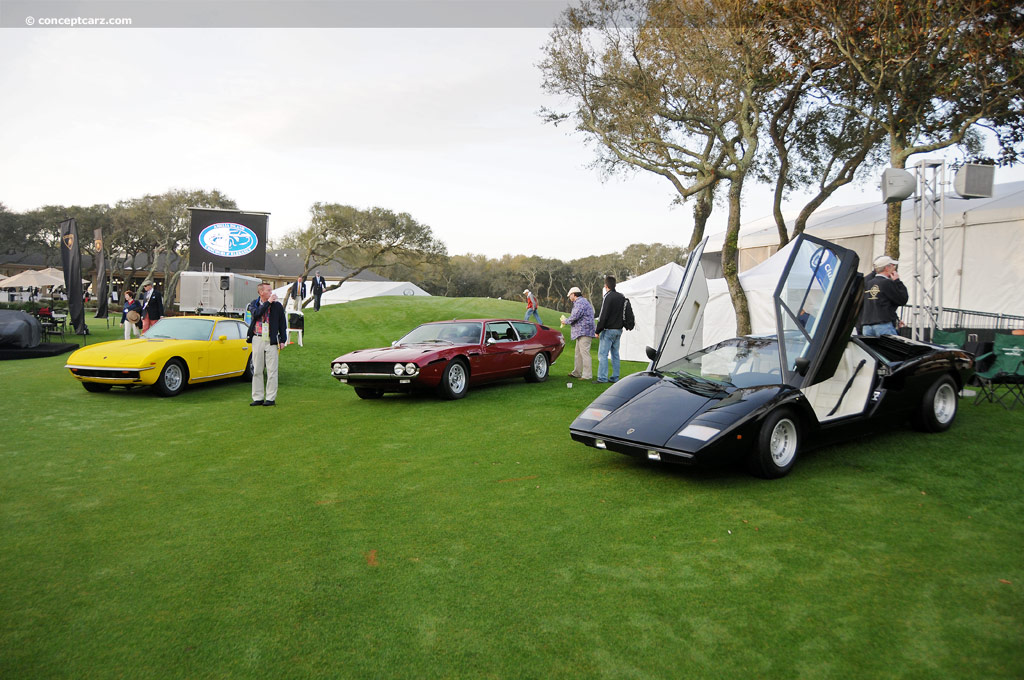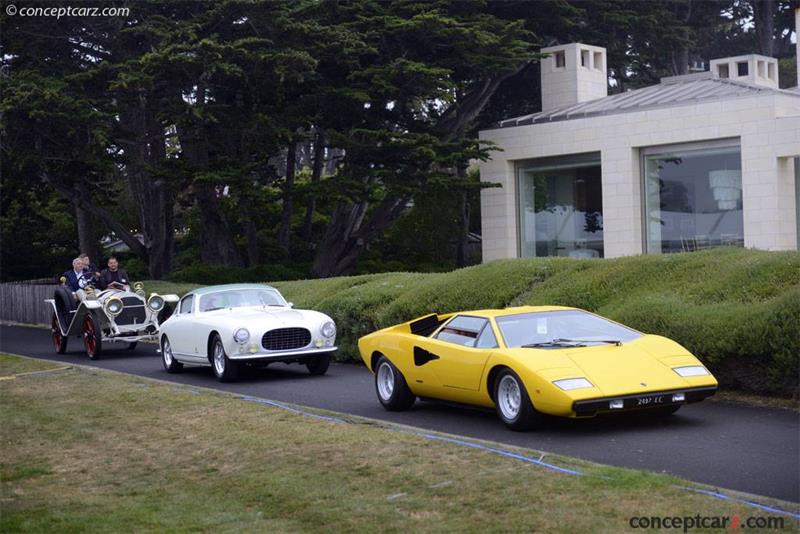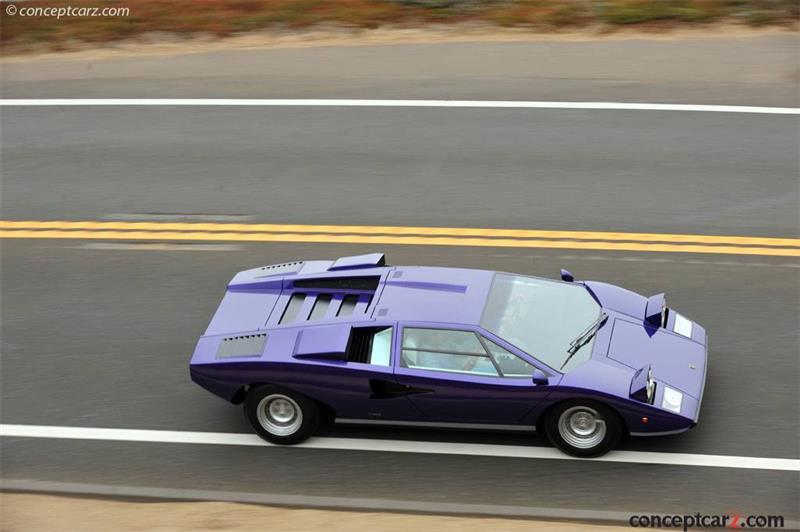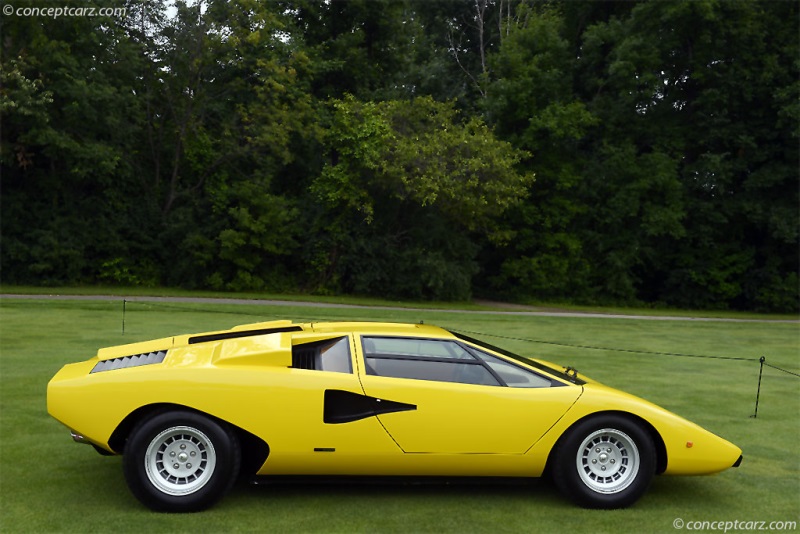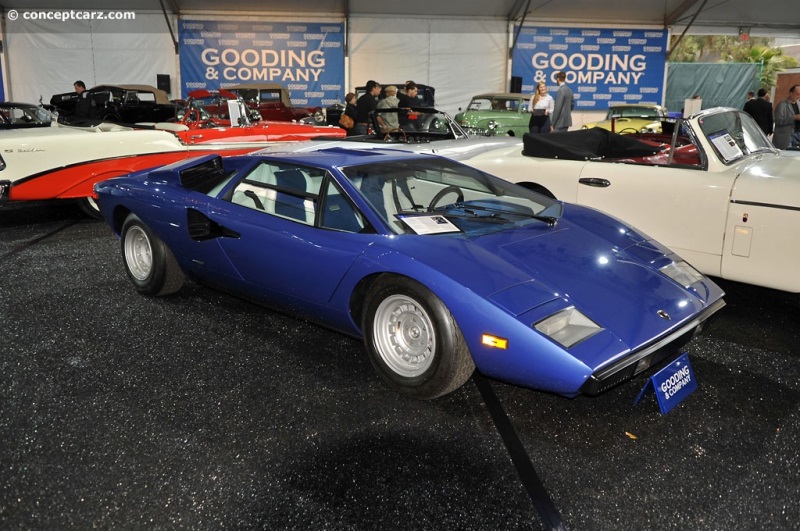When Lamborghini introduced the Countach in 1971 at the Geneva Motor Show, it garnered enough attention to warrant full production, even though it was mostly a styling exercise. Three years were spent revising the car for road use before unveiling the production version in 1974 at Geneva. Although much of its bodywork remained similar to that of the original concept, numerous modifications and changes were made to the drivetrain and chassis. The tubular chassis frame was completely redesigned by Lamborghini's engineers for greater strength, and the cooling system was revised and now utilized vertically mounted radiators that funneled air through a pair of scoops and NACA ducts. Rearward visibility improved with the use of a periscope-like mirror, installed by having a section of the bodywork in the roof cut away and replaced with glass and a rear-facing scoop. 
Coupe
Chassis #: 7A1094446
Engine #: V3818706
View info and history
Auction entries : 1The Prototypes
Three pre-production Countach prototypes were built prior to the introduction of LP400 production model. The first example was shown at the 1971 Geneva Motor Show and later used a test mule by the factory. It had a partial spaceframe steel chassis, wore bright yellow bodywork, and initially powered by a 5.0-liter V12 engine. After the engine was destroyed during testing, it was replaced by a smaller 3.-liter V12 unit similar to the one that would be used on the production LP400. Chassis number 1120001 was the second Countach prototype. Wearing an attractive red paint scheme, it was displayed in 1973 at the Geneva Motor Show, then painted green for its debut at the Paris Motor Show. It had a tubular full spaceframe chassis like the one used on the production models, and powered by a 3.9-liter engine. Its bodywork was similar to the production LP400 model, including the use of side NACA ducts and air intake boxes. The trapezoidal windows and a bumperless nose with silver, recessed grille were unique to this concept car and did not make it into production. Press releases of the era described this concept as an 'LP500' even though its 3.9-liter engine qualified it as an 'LP400.' The third and final prototype was chassis number 1120002 first shown in 1974 at the Geneva Motor Show. The chassis was built by Marchesi but the rest of the car was constructed entirely in the Lamborghini factory. It wore bright yellow paint and its body was 5.1-inches (13 centimeters) longer than the previous prototype bodies, resulting in additional interior space. The body sheet metal thickness increased from 1.2mm to 1.5mm, the suspension and gearbox mounting points were made from tubing with greater wall thickness, and it wore a slightly different wheel arch design to prevent the rear tires from rubbing during suspension compression. A three-panel window design replaced the previous trapezoidal style. Gandini's electronic diagnostic displays of the first prototype were replaced by Stewart-Warner gauges. The Name
While traditional Lamborghini models had been named after famous bulls and bullfighting, the Countach deviated from this practice. Its name originated from the Piedmontese word contacc, meaning an exclamation of astonishment. The 'LP' designation in the 'LP500' was an abbreviation of the Italian word longitudinale posteriore,' meaning 'longitudinal rear - in reference to the placement and orientation of the engine. The numerical designation that followed referenced nominal engine displacement. The '500' was for the 4.8 and 5.0-liter engines and the '400' for the 3.9-liter engines.Chassis Construction
Ferruccio Lamborghini had stunned the automotive community with the introduction of the Miura in 1966, raising the 'design bar' even further with the Countach. The project, named 'LP112,' was created in collaboration with test driver Bob Wallace, chief engineer Paolo Stanzani, assistant engineer Massimo Parenti and designer Marcello Gandini of Bertone. Aerodynamic efficiency and aesthetics were paramount as they had led to the success of the Miura. While comfort was also important, the goal of creating an uncompromising sports car was even more intriguing. Ultimately, Stanzani and his team were given permission to explore and push the boundaries of engineering and styling. The Miura had followed a similar path, but it did suffer from cooling issues, uneven weight distribution, high-speed instability, oversteer, and minimal maintenance access. The LP500 Countach prototype used an all-steel partial space frame chassis built from a steel sheet and square-section steel tubing. The rear section that would carry the engine load was built using square-section tubing with diagonal bracing and reinforced with cross-members. The front section used stamped and spot-welded sheet steel, along with welded panels and stamped ribs for reinforcement. Tubing and sheet steel stiffening frames extended through the center section, around the central transmission tunnel, and along both door sills. Although built to endure the rigors of testing, this reinforced chassis weighed 107 kg (236 lbs.) which made it much heavier than the Miura's 75 kg (165 lb.) chassis. Marchesi of Modena had produced chassis for previous Lamborghini models, and they were tasked with the construction of the prototype chassis. A second prototype chassis was built using similar dimensions and layout as the first prototype but used space frame construction of welded round-section steel tubing instead of the sheet and square tube construction of the prototype. The structure was further reinforced with cross-braced tubular frames and sheet metal gussets. Despite weighing 17 kg less than the first chassis, the second chassis was stiffer. Following testing and minor modifications, this technologically advanced, visually complex, and more expensive chassis was used on subsequent production cars.
Coupe
Chassis #: 1120172
Engine #: 1120174
View info and history
Auction entries : 3Lightweight alloy Avional was popular with aircraft construction and Stanzani considered it might be a viable material for body panel construction, but it was expensive and difficult to obtain. Aluminum alloy was ultimately selected for the LP400, and the prototypes wore a smaller thickness version than the production examples. Steel frames were welded to the main chassis and used to support the body panels, which were then hand-formed to the final body shape. Later versions of the Countach used fiberglass and carbon composites for their body components. The Engine
The engine powering the Countach was designed by Giotto Bizzarrini and originated in 1963. It was the same engine powering the preceding and then-current Lamborghini models including the Miura, but instead of a transversely-mounted orientation, it was longitudinally mounted. This earned the Countach the distinction of being the first road-going V12 with this layout. The longitudinal layout designed by Stanzani placed the output shaft at the front of the engine which connected through the clutch assembly to the transmission. Behind the engine was the rear differential. The five-speed manual used Porsche-type synchromesh and was positioned in the middle of the car, between the two seats. The driveshaft was attached to the transmission, ran through the engine's oil sump, and to the rear differential. This compact configuration allowed for a more direct gear-shift linkage with faster and easier shifting. Much of the car's mass was located near the car's center, resulting in better stability and performance. The Lamborghini V12 engine had been used in various configurations and sizes with its ultimate configuration installed in the experimental P400 Jota. It developed over 430 horsepower but it was expensive to manufacture and was not suitable for normal city driving. The Miura SV produced nearly 375 horsepower, and engineers hoped the Countach would exceed this figure. They settled on a 5-liter displacement size and although it required a major redesign, it would offer more power than previous Lamborghini engines. Only one experimental engine was ever constructed and was later destroyed during a road test in 197 by Bob Wallace. The 3.9-liter engine block had been enlarged to 5-liters and many castings were built from Elektron.
Coupe
Chassis #: 1120172
Engine #: 1120174
View info and history
Auction entries : 3Subsequent prototypes and the first production cars used a 3.9-liter (3929cc) engine while work continued on a durable 5-liter unit. It had a 60-degree cylinder bank angle, two valves per cylinder, double overhead camshafts per bank, and distributor ignition. With side-draft Weber 45 DCOE carburetors, the engine delivered 370 horsepower at 8,000 RPM, less than the output of the Miura which used down-draft carburetors. In 1982, engine displacement grew to 4,754cc (4.8-liters) on the LP500S, and then to 5,167cc (5.2-liters) with four valves per cylinder in the 1985 LP5000 Quattrovalvole. Some of the LP5000 QV models used Bosch K-Jetronic fuel injection to meet US emissions regulations, while all other versions of the Countach relied on six Weber carburetors. Styling by Marcello Gandini of Bertone
Marcello Gandini's fascination with angular and geometric designs was successfully applied to the Miura, and various concept cars created for Lancia, Alfa Romeo, and Lamborghini. The commercial success of the Miura prompted the continuation of this design study, with wedge-shaped, mid-engine design inspiration sourced from the 1968 Alfa Romeo Carabo and 1970 Lancia Stratos Zero. Scissor doors were used on the Carabo and the Stratos Zero had a hinged windshield for entry into the passenger compartment. Both designs were revolutionary, but only the scissor doors of the Carabo were used on the Countach. The Countach LP500 prototype displayed in 1971 at Geneva had a wedge-shaped design, stood 41 inches tall and 158-inches long, was devoid of bumpers, side mirrors, and aerodynamic spoilers, with trapezoidal shapes used throughout the body, including the taillights, engine covers, door openings, windshield, and side windows. The side-mounted radiators and louvered vents provided air to the engine, but this was proven inadequate during road tests.
Coupe
Chassis #: 1120172
Engine #: 1120174
View info and history
Auction entries : 3Opening the scissor doors revealed an equally futurist interior, albeit without the all-digital readouts initially penned by Gandini, replaced by conventional dials. There was an on-board diagnostic system that displayed the status of the car's subsystems, and warning lights centrally located on the single-spoke steering wheel. There were deeply recessed bucket seats on either side of the prominent transmission tunnel. Countach styling continued to evolve and change as new production models were introduced. These were done to improve upon aesthetics, for better aerodynamics and increased stability at speed, comply with mandated safety requirements, and improve engine cooling. LP400
The Lamborghini Countach LP400 was the first production version of the Countach and was equipped with a 3,929cc engine offering 370 horsepower. Although it was true to the preceding concept's design, several modifications were made, including the use of conventional lights instead of the futuristic light clusters of the prototype. They used a periscope rear-view mirror while subsequent Countach models used conventional rearview mirrors. The slope of the nose was shallower to reduce front-end downforce that had destabilized the prototype during braking, and the overall dimensions were slightly larger. Large air scoops and vents provided the necessary airflow to keep the engines from overheating.
Coupe
Chassis #: 1120172
Engine #: 1120174
View info and history
Auction entries : 3While subsequent Countach models would display engine displacement or valve arrangments, the LP400 emblems at the rear simply rear 'Lamborghini' and 'Countach.' Production of the LP400 lasted through the end of 1977, with a total of 158 examples produced. LP400 S
The LP400 was succeeded in 1978 by the LP 400 S, equipped with a slightly detuned 350 horsepower engine, and riding on the widest tires (Pirelli P7 345/35R15) ever installed on a production car up to that point in history. To contain the large wheels, fiberglass wheel arch extensions were added. Buyers were given the option of a V-shaped rear wing which improved stability at high speed but reduced the top speed by at least 10 mph. Most owners preferred the appearance of the wing and selected this option.
Coupe
Chassis #: 1120192
View info and historyThe total production of the LP400 S was 237 units through three distinct series. LP500 S
The LP500 S was introduced in 1982 and came with a more powerful 4,754cc (4.8-liter) engine and an updated interior. The bodywork remained the same as the Series III LP 400 S.LP5000 Quattrovalvole
The engine powering the LP5000 Quattrovalvole (QV) displaced 5,167 cc (5.2-liters) with 4 valves per cylinder (thus the name quattrovalvole). With the Bosch K-Jetronic fuel injection system in place, it developed 414 horsepower. European version with six Weber carburetors delivered 450 horsepower at 7,000 RPM. The cooling of the carburetors was improved by moving them from the sides to the top of the engine, which required a hump on the engine cover, reducing rear visibility even further. 25th Anniversary Edition
The 25th Anniversary Edition arrived in 1988 and was the perfect thoroughbred to allow the Countach to leave the bullring. It was mechanically similar to the 5000QV, but featured air-conditioning, and a restyling by Horacio Pagani resulting in smoother contours and redesigned fins.
Coupe
Chassis #: 1120154
Engine #: 1120154
View info and history
Auction entries : 2Production of the 25th Anniversary Countach continued until 1990 when it was superseded by the Lamborghini Diablo.
by Daniel Vaughan | Sep 2021
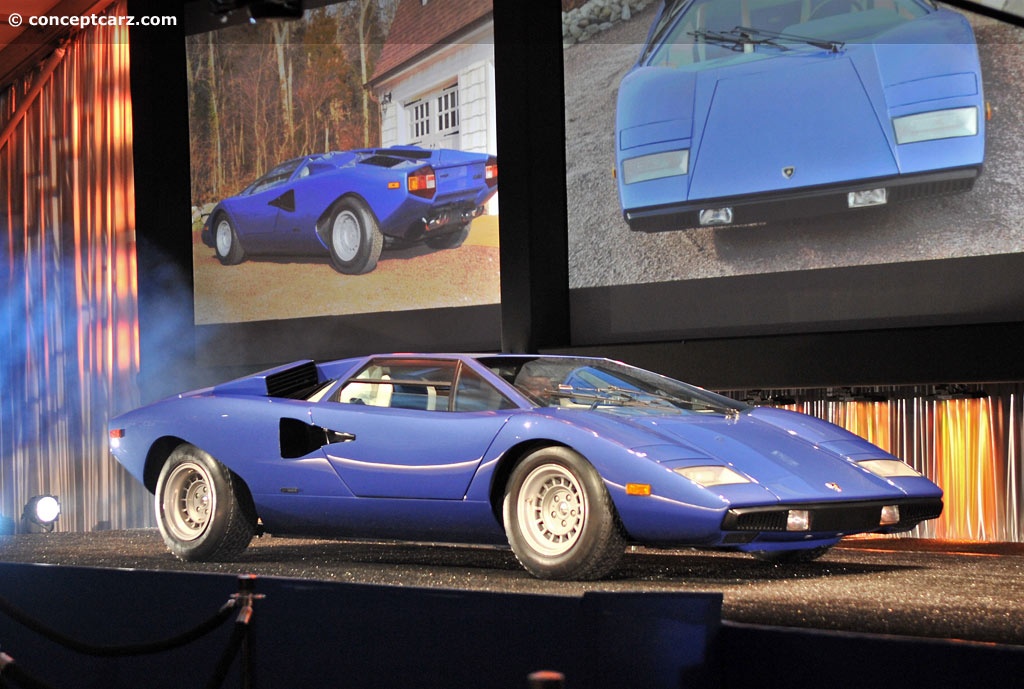
Coupe
Chassis #: 7A1094446
Engine #: V3818706
View info and history
Auction entries : 1
Three pre-production Countach prototypes were built prior to the introduction of LP400 production model. The first example was shown at the 1971 Geneva Motor Show and later used a test mule by the factory. It had a partial spaceframe steel chassis, wore bright yellow bodywork, and initially powered by a 5.0-liter V12 engine. After the engine was destroyed during testing, it was replaced by a smaller 3.-liter V12 unit similar to the one that would be used on the production LP400. Chassis number 1120001 was the second Countach prototype. Wearing an attractive red paint scheme, it was displayed in 1973 at the Geneva Motor Show, then painted green for its debut at the Paris Motor Show. It had a tubular full spaceframe chassis like the one used on the production models, and powered by a 3.9-liter engine. Its bodywork was similar to the production LP400 model, including the use of side NACA ducts and air intake boxes. The trapezoidal windows and a bumperless nose with silver, recessed grille were unique to this concept car and did not make it into production. Press releases of the era described this concept as an 'LP500' even though its 3.9-liter engine qualified it as an 'LP400.' The third and final prototype was chassis number 1120002 first shown in 1974 at the Geneva Motor Show. The chassis was built by Marchesi but the rest of the car was constructed entirely in the Lamborghini factory. It wore bright yellow paint and its body was 5.1-inches (13 centimeters) longer than the previous prototype bodies, resulting in additional interior space. The body sheet metal thickness increased from 1.2mm to 1.5mm, the suspension and gearbox mounting points were made from tubing with greater wall thickness, and it wore a slightly different wheel arch design to prevent the rear tires from rubbing during suspension compression. A three-panel window design replaced the previous trapezoidal style. Gandini's electronic diagnostic displays of the first prototype were replaced by Stewart-Warner gauges. The Name
While traditional Lamborghini models had been named after famous bulls and bullfighting, the Countach deviated from this practice. Its name originated from the Piedmontese word contacc, meaning an exclamation of astonishment. The 'LP' designation in the 'LP500' was an abbreviation of the Italian word longitudinale posteriore,' meaning 'longitudinal rear - in reference to the placement and orientation of the engine. The numerical designation that followed referenced nominal engine displacement. The '500' was for the 4.8 and 5.0-liter engines and the '400' for the 3.9-liter engines.Chassis Construction
Ferruccio Lamborghini had stunned the automotive community with the introduction of the Miura in 1966, raising the 'design bar' even further with the Countach. The project, named 'LP112,' was created in collaboration with test driver Bob Wallace, chief engineer Paolo Stanzani, assistant engineer Massimo Parenti and designer Marcello Gandini of Bertone. Aerodynamic efficiency and aesthetics were paramount as they had led to the success of the Miura. While comfort was also important, the goal of creating an uncompromising sports car was even more intriguing. Ultimately, Stanzani and his team were given permission to explore and push the boundaries of engineering and styling. The Miura had followed a similar path, but it did suffer from cooling issues, uneven weight distribution, high-speed instability, oversteer, and minimal maintenance access. The LP500 Countach prototype used an all-steel partial space frame chassis built from a steel sheet and square-section steel tubing. The rear section that would carry the engine load was built using square-section tubing with diagonal bracing and reinforced with cross-members. The front section used stamped and spot-welded sheet steel, along with welded panels and stamped ribs for reinforcement. Tubing and sheet steel stiffening frames extended through the center section, around the central transmission tunnel, and along both door sills. Although built to endure the rigors of testing, this reinforced chassis weighed 107 kg (236 lbs.) which made it much heavier than the Miura's 75 kg (165 lb.) chassis. Marchesi of Modena had produced chassis for previous Lamborghini models, and they were tasked with the construction of the prototype chassis. A second prototype chassis was built using similar dimensions and layout as the first prototype but used space frame construction of welded round-section steel tubing instead of the sheet and square tube construction of the prototype. The structure was further reinforced with cross-braced tubular frames and sheet metal gussets. Despite weighing 17 kg less than the first chassis, the second chassis was stiffer. Following testing and minor modifications, this technologically advanced, visually complex, and more expensive chassis was used on subsequent production cars.

Coupe
Chassis #: 1120172
Engine #: 1120174
View info and history
Auction entries : 3
The engine powering the Countach was designed by Giotto Bizzarrini and originated in 1963. It was the same engine powering the preceding and then-current Lamborghini models including the Miura, but instead of a transversely-mounted orientation, it was longitudinally mounted. This earned the Countach the distinction of being the first road-going V12 with this layout. The longitudinal layout designed by Stanzani placed the output shaft at the front of the engine which connected through the clutch assembly to the transmission. Behind the engine was the rear differential. The five-speed manual used Porsche-type synchromesh and was positioned in the middle of the car, between the two seats. The driveshaft was attached to the transmission, ran through the engine's oil sump, and to the rear differential. This compact configuration allowed for a more direct gear-shift linkage with faster and easier shifting. Much of the car's mass was located near the car's center, resulting in better stability and performance. The Lamborghini V12 engine had been used in various configurations and sizes with its ultimate configuration installed in the experimental P400 Jota. It developed over 430 horsepower but it was expensive to manufacture and was not suitable for normal city driving. The Miura SV produced nearly 375 horsepower, and engineers hoped the Countach would exceed this figure. They settled on a 5-liter displacement size and although it required a major redesign, it would offer more power than previous Lamborghini engines. Only one experimental engine was ever constructed and was later destroyed during a road test in 197 by Bob Wallace. The 3.9-liter engine block had been enlarged to 5-liters and many castings were built from Elektron.
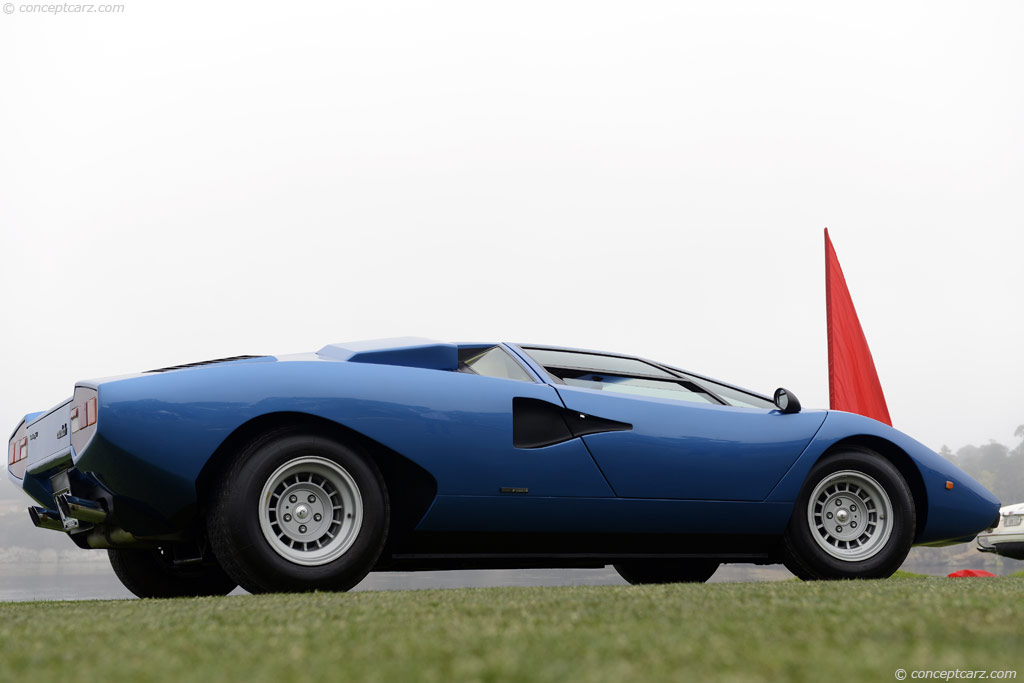
Coupe
Chassis #: 1120172
Engine #: 1120174
View info and history
Auction entries : 3
Marcello Gandini's fascination with angular and geometric designs was successfully applied to the Miura, and various concept cars created for Lancia, Alfa Romeo, and Lamborghini. The commercial success of the Miura prompted the continuation of this design study, with wedge-shaped, mid-engine design inspiration sourced from the 1968 Alfa Romeo Carabo and 1970 Lancia Stratos Zero. Scissor doors were used on the Carabo and the Stratos Zero had a hinged windshield for entry into the passenger compartment. Both designs were revolutionary, but only the scissor doors of the Carabo were used on the Countach. The Countach LP500 prototype displayed in 1971 at Geneva had a wedge-shaped design, stood 41 inches tall and 158-inches long, was devoid of bumpers, side mirrors, and aerodynamic spoilers, with trapezoidal shapes used throughout the body, including the taillights, engine covers, door openings, windshield, and side windows. The side-mounted radiators and louvered vents provided air to the engine, but this was proven inadequate during road tests.

Coupe
Chassis #: 1120172
Engine #: 1120174
View info and history
Auction entries : 3
The Lamborghini Countach LP400 was the first production version of the Countach and was equipped with a 3,929cc engine offering 370 horsepower. Although it was true to the preceding concept's design, several modifications were made, including the use of conventional lights instead of the futuristic light clusters of the prototype. They used a periscope rear-view mirror while subsequent Countach models used conventional rearview mirrors. The slope of the nose was shallower to reduce front-end downforce that had destabilized the prototype during braking, and the overall dimensions were slightly larger. Large air scoops and vents provided the necessary airflow to keep the engines from overheating.
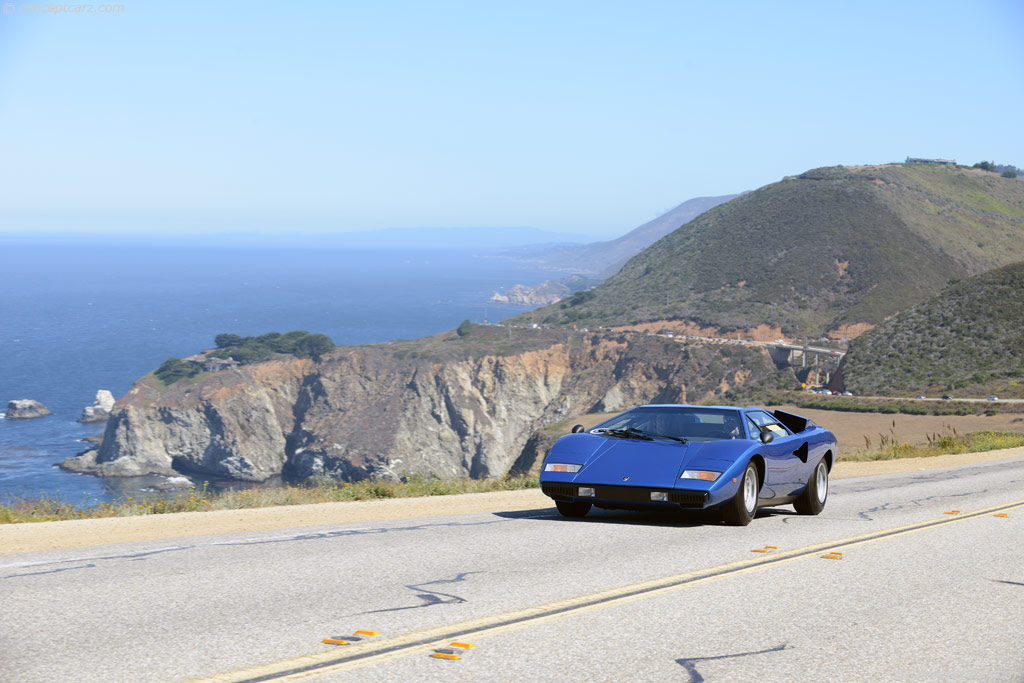
Coupe
Chassis #: 1120172
Engine #: 1120174
View info and history
Auction entries : 3
The LP400 was succeeded in 1978 by the LP 400 S, equipped with a slightly detuned 350 horsepower engine, and riding on the widest tires (Pirelli P7 345/35R15) ever installed on a production car up to that point in history. To contain the large wheels, fiberglass wheel arch extensions were added. Buyers were given the option of a V-shaped rear wing which improved stability at high speed but reduced the top speed by at least 10 mph. Most owners preferred the appearance of the wing and selected this option.
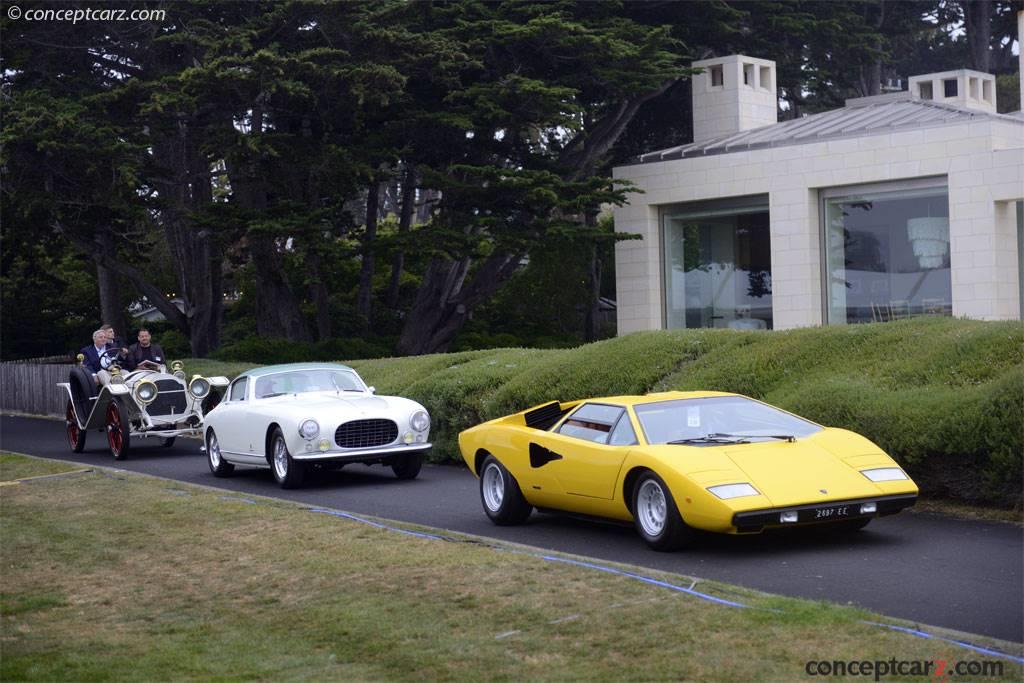
Coupe
Chassis #: 1120192
View info and history
The LP500 S was introduced in 1982 and came with a more powerful 4,754cc (4.8-liter) engine and an updated interior. The bodywork remained the same as the Series III LP 400 S.LP5000 Quattrovalvole
The engine powering the LP5000 Quattrovalvole (QV) displaced 5,167 cc (5.2-liters) with 4 valves per cylinder (thus the name quattrovalvole). With the Bosch K-Jetronic fuel injection system in place, it developed 414 horsepower. European version with six Weber carburetors delivered 450 horsepower at 7,000 RPM. The cooling of the carburetors was improved by moving them from the sides to the top of the engine, which required a hump on the engine cover, reducing rear visibility even further. 25th Anniversary Edition
The 25th Anniversary Edition arrived in 1988 and was the perfect thoroughbred to allow the Countach to leave the bullring. It was mechanically similar to the 5000QV, but featured air-conditioning, and a restyling by Horacio Pagani resulting in smoother contours and redesigned fins.
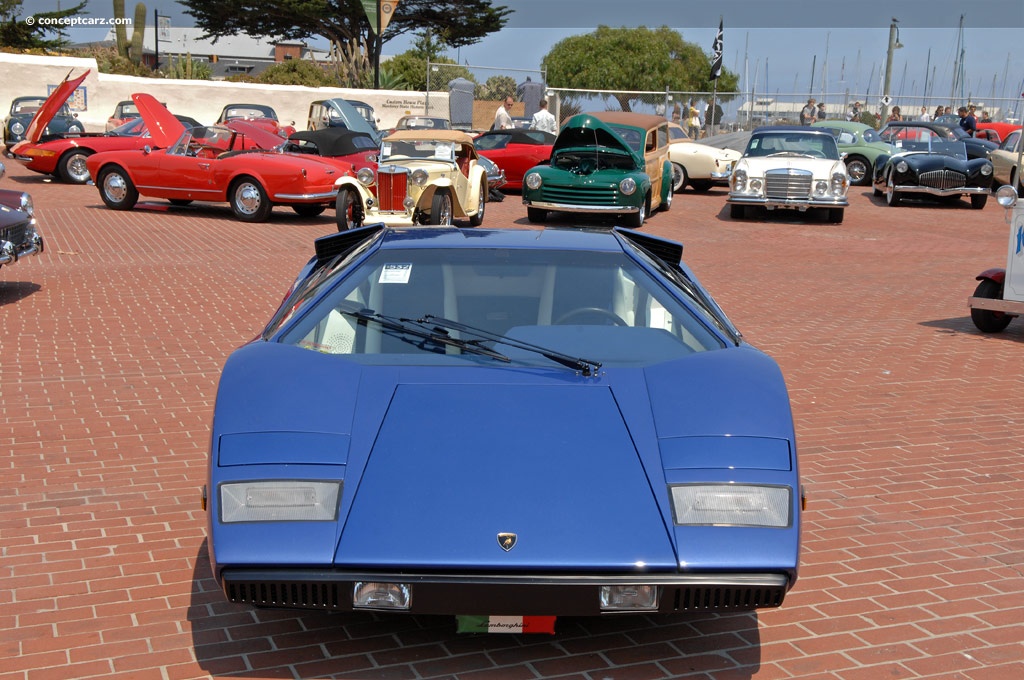
Coupe
Chassis #: 1120154
Engine #: 1120154
View info and history
Auction entries : 2
by Daniel Vaughan | Sep 2021
Related Reading : Lamborghini Countach History
The Lamborghini Countach was the predecessor to the very successful Miura, and it wore a body designed by Marcello Gandini at Bertone, with exotic mid-engine layout in a two-door coupe configuration. It featured an attractive, wedge-shaped, and angular body with elegant lines and fitted with modern mechanical components and technology. The engine was mounted longitudinally and replaced the transverse....
Continue Reading >>
Continue Reading >>
Similar Automakers
Similarly Sized Vehicles
from 1976
1976 Lamborghini Countach LP400 Vehicle Profiles
Recent Vehicle Additions
Performance and Specification Comparison
Price Comparison
Countach LP400 Specification Comparison by Year
Year
Production
Wheelbase
Engine
Prices
Related Automotive News

Countach and LM 002: the Lamborghini V12 shows to be multi-purpose
In the year of celebrations for the V12, the story of two models that are diametrically opposed but share the same extraordinary 12-cylinder mechanics
This year, Lamborghini is celebrating its V12, the legendary 12-cylinder engine that for nearly...

The legacy of the Lamborghini Countach in a video series. From the idea car, the LP 500 of 1971, to five generations spanning seventeen years
In its celebration of the 50th anniversary of the Countach, Automobili Lamborghini is launching a series of four videos on its social media channels. Every Monday they will recount the legacy of an automotive icon in an unprecedented manner, by involving...

Lamborghini Miura SV turns 50 in 2021
The Lamborghini Miura SV, the last evolution of the highly successful P400 project, was officially unveiled in March 1971, on the Lamborghini stand at the Geneva Motor Show. On the same occasion, on its stand, Carrozzeria Bertone presented the Countach...

Lamborghini Celebrates The 50Th Anniversary Of The Jarama GT
This year marks the 50th Anniversary of the Lamborghini Jarama GT, presented for the first time at the Geneva Motor Show in March 1970.
The Jarama, whose name derives from an area north of Madrid famous for breeding fighting bulls, was the latest evolution...

The Best Of Lamborghini At London Concours 2020
The London Concours has announced its Great Marques Lamborghini display, celebrating the very best from SantAgata
Line-up includes icons early pioneers like the 400GT and iconic Miura, through to the Diablo SV, Murcielago and Aventador SVJ
Les...

Lamborghini Miura Celebrated In A Dedicated Class At The 59Th Pebble Beach Concours d'Elegance
SantAgata Bolognese, 12 August 2019 – The Pebble Beach Concours dElegance, established in 1950, is the one of the most renowned classic car shows in the world, and every year the selection of cars for display is very severe, because only the...
